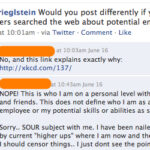The current crop of adults grew up in a world of physical identity where behavior was modulated according to where someone was. The audience was clear. One could swear in front of friends – Not at school.
The current generation of students grew up in a world largely influenced by digital identity were the reality, consciously noted or not, was that context was in the eye of the searcher.
If you google my name, you will get my myspace blogs, written for friends, press releases written for corporate audiences, and if you search deep, you will find some early college poetry that got posted with an early online college magazine. Google does not care what my originating context was. It’s up to you, the searcher, to cut me some slack for my 11-year-old poetry.
Students reasonably expect some flexibility around appropriate behavior and context. The overlap and muddiness of “appropriate in context” is simply a fact of the tools they grew up with. They are more public and forgiving because of it.
If your paradigm is based on a lifetime of physical identity, with its clear boundaries and expectations, this muddiness is extremely difficult to understand.
No one is wrong. It’s just different ways of looking at it, based on different experiences.
It’s easy to say that the old folks or the young folks “just don’t get it” – it’s just not very accurate.
These graphics were inspired by a conversation with Scott Silverman about his dissertation, THE EFFECTS OF OSN COMMUNITIES ON COLLEGE STUDENTS’ EXPERIENCES. HOW CAN STUDENT AFFAIRS PROFESSIONALS BEST RESPOND TO THIS EMERGENT PHENOMENON – and it’s well worth a read if you are at all interested in Student Affairs. You can find it here**.




